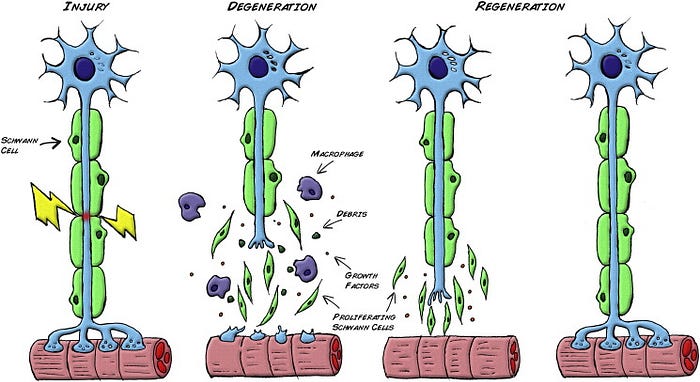
Nerve repair and regeneration is the process by which the body repairs or replaces damaged or injured nerves.
When a muscle is injured, the immune system reacts to the injury and begins to cleanse the area. Special cells called Schwann cells begin to multiply and form a new protective layer around the damaged nerve.
In some cases, damaged nerve fibers can reconnect on their own, allowing nerve regeneration. However, in more severe cases, surgery or other medical procedures may be needed to repair or rebuild the damaged nerve. The global Nerve Repair and Regeneration Market Size was valued at $6.6 billion in 2020 and is projected to reach $12.3 billion by 2030, growing at a CAGR of 6.5% from 2021 to 2030.
The process of repairing and regenerating muscles can take time because muscles grow slowly. The rate of recovery depends on the type of muscle and the severity of the injury, but it can take several months or even years. However, with proper treatment and rehabilitation, many people are able to regain some or all of their lost nerve function. COVID-19 has had a positive and negative impact on the nerve repair and manufacturing industry.
Positive effects:
Improved research: COVID-19 has improved research in the area of nerve repair and regeneration. Researchers are working to develop a treatment for COVID-19 that can be used to treat nerve damage.
Increased funding: The pandemic has also led to increased investment in medical research and development, which has helped support research into nerve repair and regeneration. Adverse effects:
Clinical trials delayed: Many clinical trials in nerve repair and regeneration have been suspended due to COVID-19. This has slowed the development of new treatments and therapies. Supply Chain Disruption: The pandemic has disrupted the process of nerve repair and product and manufacturing equipment, causing delays in production and delivery.
Reduced access to health care: The pandemic has reduced access to health services, including nerve repair and rehabilitation, for many patients due to lockdowns, restrictions and an overburdened health system. In summary, COVID-19 has had both positive and negative impacts on the nerve repair and manufacturing industry. While the pandemic has accelerated research and increased investment, it has led to delays in clinical trials and supply chain disruptions, as well as reduced access to healthcare for many patients. Muscle repair and rehabilitation is used in many areas of the medical industry. Here are some of the main features:
Neurosurgery: Neurosurgery is an important part of neurosurgery, which involves the diagnosis and treatment of conditions affecting the brain, spinal cord, and nerves. Surgeons use nerve repair and rehabilitation techniques to treat conditions such as peripheral nerve damage, spinal cord injuries, and brain injuries.
Orthopedics: Also used in the repair and rehabilitation of muscles and bones, which is the branch of medicine that deals with conditions that affect the body system. Orthopedic surgeons use nerve repair and rehabilitation techniques to treat conditions such as carpal tunnel syndrome, cubital tunnel syndrome, and nerve damage associated with bone fractures.
Plastic surgery: Plastic surgeons use nerve repair and regeneration techniques to restore nerve function after reconstructive surgery, such as after breast reconstruction or after a facial injury. Rehabilitation Medicine: Rehabilitation medicine specialists use nerve repair and rehabilitation techniques as part of their treatment plans for patients recovering from injuries or neurological or neurological conditions.
Research and development: The nerve repair and manufacturing industry involves the research and development of new treatments, processes and technologies to improve the results of nerve repair and regeneration. Overall, nerve repair and regeneration is a critical part of many healthcare industry sectors, helping to improve patient outcomes and quality of life.
0 Comments